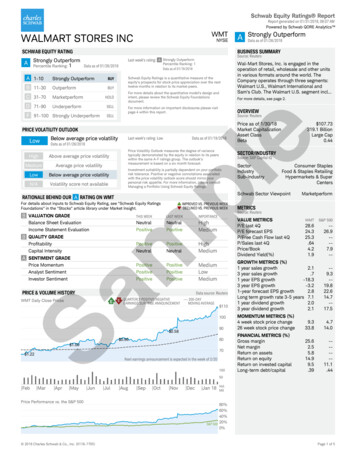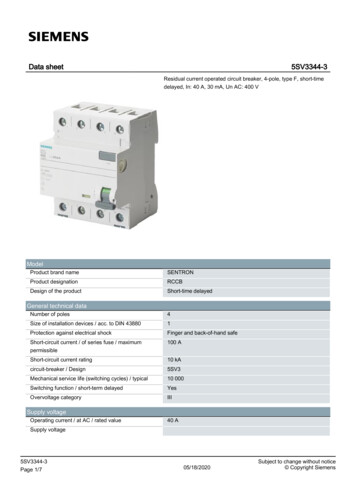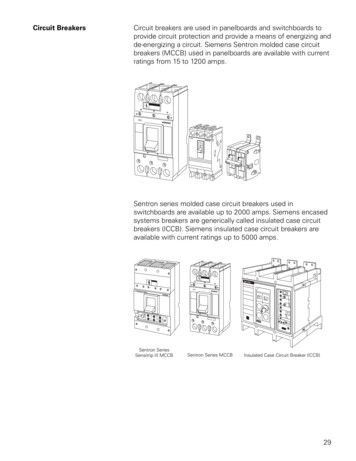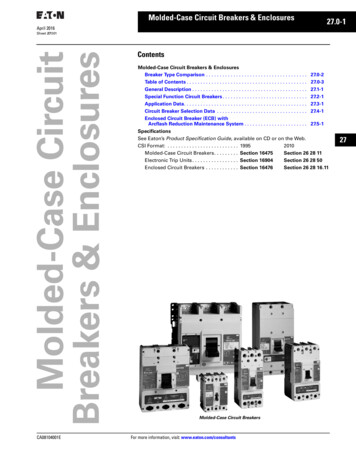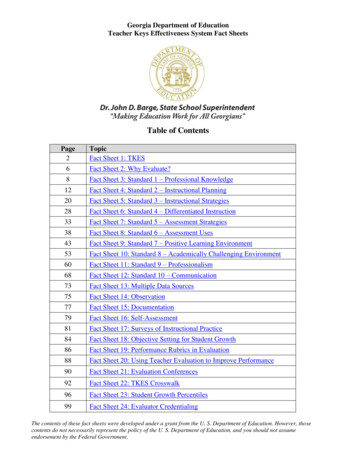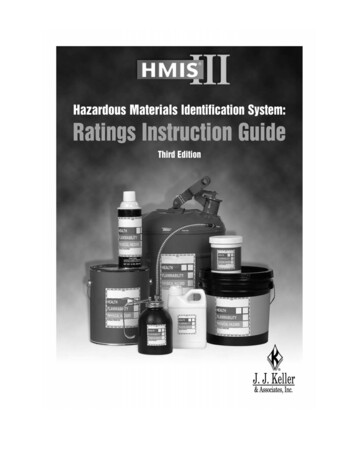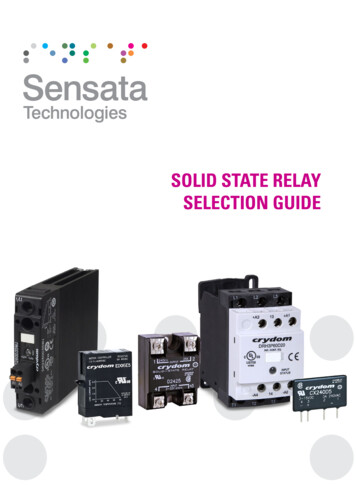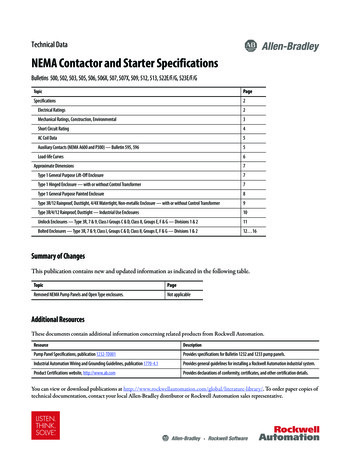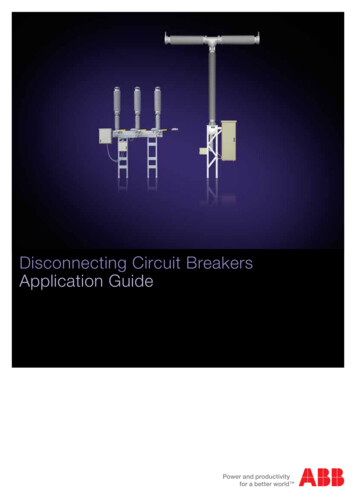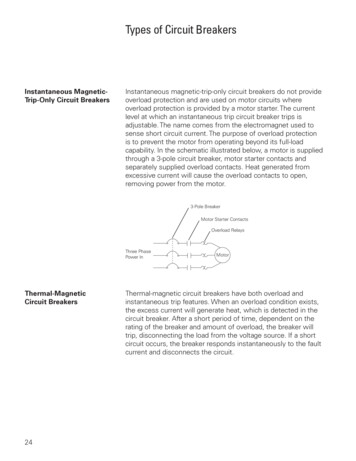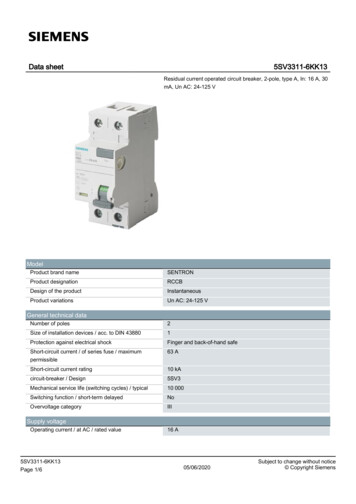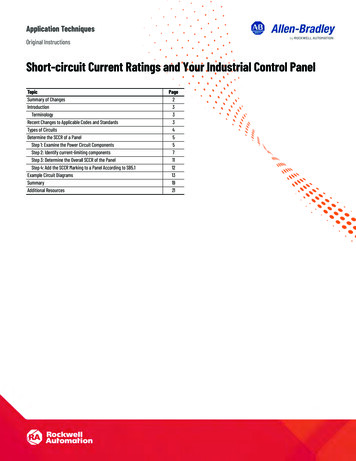
Transcription
Application TechniquesOriginal InstructionsShort-circuit Current Ratings and Your Industrial Control PanelTopicSummary of ChangesIntroductionTerminologyRecent Changes to Applicable Codes and StandardsTypes of CircuitsDetermine the SCCR of a PanelStep 1: Examine the Power Circuit ComponentsStep 2: Identify current-limiting componentsStep 3: Determine the Overall SCCR of the PanelStep 4: Add the SCCR Marking to a Panel According to SB5.1Example Circuit DiagramsSummaryAdditional ResourcesPage233345571112131921
Short-circuit Current Ratings and Your Industrial Control PanelSummary of ChangesThis publication contains the following new or updated information. This list includes substantive updates only and is not intended to reflectall changes.TopicCorrected definition of feeder circuitReformatted2Page4throughoutRockwell Automation Publication SCCR-AT002B-EN-P - September 2020
Short-circuit Current Ratings and Your Industrial Control PanelIntroductionInformation in this document is based on UL 508A Standard for Safety Industrial Control Panels, Third Edition, Dated April 24, 2018 and NFPA70 NEC (National Electrical Code) 2017. NEC Article 409 requires panels to be marked with a short-circuit current rating (SCCR). In aninformational note, Article 409 references UL 508A, specifically Supplement SB4, as an approved method of calculating the SCCR of a panel.Article 409 also states that an industrial control panel that contains only control circuit components does not need an SCCR rating.The purpose of this document is to provide examples for short-circuit current ratings of panels based on the methods stated in UL 508ASupplement B. While other standards require short-circuit ratings, this document focuses on UL 508A SB4 and SB5, short circuit and panelmarking. Please note that this document is an interpretation of the standard, which is the only source of the guidelines and rules that youmust follow. Descriptions of the standards and requirements are brief and not binding.Both the actual NEC and UL 508A publications contain detailed guidelines and must be adhered to. This document does not replace the codeand the standards.A UL inspector and/or Authority Having Jurisdiction (AHJ) has the final ruling on code interpretation. The definition for the AHJ can be foundin NEC Article 90.4 (Enforcement).IMPORTANTThe examples and diagrams in this publication are included solely for illustrative purposes. Because of themany variables and requirements associated with any particular installation, Rockwell Automation, Inc. cannotassume responsibility or liability for actual use based on the examples and diagrams.No patent liability is assumed by Rockwell Automation, Inc. with respect to use of information, circuits,equipment, or software described in this publication.TerminologyThe abbreviations used in the wiring examples in this document are as follows: CB—circuit breakerCONT—contactorHMI—human-machine interfaceOL—overload relayMFG—manufacturingMPCB—motor protection circuit breakerMTR—motorPDB—power distribution blockPLC—programmable logic controllerPS—power supplyVFD—variable-frequency driveRecent Changes to Applicable Codes and StandardsThis section provides information about some of the recent changes to the 2017 version of the NEC.Because industrial control panels are required to have SCCR ratings that meet or exceed the available fault current, it is important to knowwhat the fault current values are. The fault current information is used to properly size the feeder and the branch circuit protective device(BCPD).Rockwell Automation Publication SCCR-AT002B-EN-P - September 20203
Short-circuit Current Ratings and Your Industrial Control PanelChanges to the 2017 version of the NECArticle 409 of the NEC covers installation of industrial control panels at and under 1000 volts. This article previously applied to installationsup to 600 volts. The scope of UL 508A 3rd addition, 2018, Chapter 1.1. also reflects this change.Previously, 110.24 addressed the standard for field marking the documented date of the fault current calculation on service equipment.Article 409.22 has added guidelines to document the available fault current that feeds the control panel and the date of the calculation. Thecontrol panel needs to be able to handle the available fault current. Article 409.22 also references 409.110(4), which requires that the SCCR islisted on the panel label. Article 409.110(4) also states the SCCR can be established using an approved method, such as UL 508AArticle 670.5 (1) changed the term from fault current to short-circuit current. This change occurs in other articles, such as 409.22. Article670.5(2) also added the requirement to field mark a panel to include the date the short-circuit current calculation was performed. The labelalso lists the maximum available fault current.Changes to UL 508A, 3rd EditionIn addition to the expanded scope defined in UL508A, Chapter 1.1 that was already mentioned, there are several other changes that youshould be aware of.Chapter 2.10 Combination Motor Controller: even though this chapter is not new to the standard, Chapter 2.10 is specified throughout UL508Awhen it comes to short-circuit ratings. A combination motor controller has a disconnecting means, branch circuit protection (BCP), motorcontrol (contactor or other device), and an overload device.Chapter 2.36, One-Port surge protection device (SPD), is a new description for a surge protection device that does not have a means ofapplying current to the load. Because it cannot apply current to the load, a one-port SPD does not need to have an SCCR rating. UL 508A,SB4.2.1 contains more information about these devices.Chapter 2.44 contains the following definition for SCCR: “the fault current at a nominal voltage to which an apparatus or system is able to beconnected without sustaining damage exceeding the defined acceptance criteria” (as defined in UL 508A, April 24, 2018).Table SB4.4, three-phase transformer secondary table, has been updated with lower values than previous versions of the code.Types of CircuitsFigure 1 depicts the four different potential circuits that you may find in a panel. Understanding the different circuits is important forunderstanding the SCCR of the panel. 4Feeder Circuit—feeder circuits supply the power to the supply side of the branch circuit overcurrent device. Typically, this consists ofincoming cables, a disconnect switch, power distribution block, and so on, all the way to the line side of the last branch circuit device.Branch Circuit—branch circuits run from the branch overcurrent protection device to the load. These also include control circuits.Control Circuit—control circuits perform the on/off and other control functions in a panel.Power Circuit—a power circuit is every circuit minus the control circuits.Rockwell Automation Publication SCCR-AT002B-EN-P - September 2020
Short-circuit Current Ratings and Your Industrial Control PanelFigure 1 - Sample Circuit DiagramFeeder CircuitClass 1 ControlCircuitClass 1 ControlCircuitBranch Circuit 1Branch Circuit 2Class 2 Control CircuitDetermine the SCCR of a PanelAccording to UL 508A, Supplement SB, there are four basic steps you need to follow to determine the SCCR rating of a panel and comply withthe standard.1.2.3.4.Look at the individual power circuit components in each branch circuit according to SB4.2.Look for any possible current limiting components to possibly modify SCCR according to SB4.3.Determine the overall SCCR of the panel according to the explanation in SB4.4.Add the SCCR marking to panel according to SB5.1.Step 1: Examine the Power Circuit ComponentsThis step helps you to determine whether your power components meet the ratings requirements for your application.Paragraph SB4.2.1Power circuit components are generally required to have short-circuit ratings. Some components, such as voltmeters, EMI filters, and powerresistors, are exempt from these requirements. Paragraph SB4.2.1 lists additional components that do not require SCCR.Table SB4.1 lists the default SCCR ratings for components that are not tested or marked.Paragraph SB4.2.2Paragraph SB4.2.2 requires that you use one of three values to determine the SCCR of the feeder or branch circuit component:Rockwell Automation Publication SCCR-AT002B-EN-P - September 20205
Short-circuit Current Ratings and Your Industrial Control PanelThe first option is to use the manufacturer’s tested rating, which you can find on the component label, packaging, or separate instructionsheet. See Figure 2.Figure 2 - Manufacturer’s Tested Rating LocationsInstruction sheet exampleComponent label exampleThe second option is to use the values provided in Table SB4.1. Table SB4.1 provides the UL standard default short-circuit current ratings thatyou can use when your device is not marked or data is not provided by the manufacturer. This method is very conservative in nature.The final method of determining the SCCR of individual components is to use the product test data that is provided by the devicemanufacturer. Using this data ensures that any necessary testing has already been completed, typically with the appropriate branch circuitprotectionFigure 3 shows an example of the data that Rockwell Automation provides via our Global SCCR Tool. Sometimes, the same product,depending on how it is used, will have different ratings. For this reason, we recommend that you verify ratings for every component orcombination that you are using.Figure 3 - Rockwell Automation SCCR Tool Sample Results6Rockwell Automation Publication SCCR-AT002B-EN-P - September 2020
Short-circuit Current Ratings and Your Industrial Control PanelParagraph SB4.2.3Paragraph SB4.2.3 states that you can only use the specified breaker or fuse for high fault SCCR for a feeder or branch component asindicated in SB4.2.2 (a) or (c). There are four exceptions to this rule. A branch fuse of a different class can be substituted where the peak let-through current and I2t of the new fuse is not greater thanthat of the specified fuse.If marked in accordance to SB5.1.2, a branch circuit protection can be provided in the field.A listed circuit breaker marked ‘current limiting’ can be replaced by another current-limiting circuit breaker if the I2t and peak letthrough are not greater than the specified breaker.A specified non-current limiting device can be replaced by a current limiting fuse that has an interrupting rating no less than thespecified fuse and where the rated current is less than or equal to the rated current. You can use Table SB4.2 to obtain these values.Step 2: Identify current-limiting componentsParagraph SB4.3 guides you through determining SCCR for current-limiting devices. The sections of note are: SB4.3—Limiting short circuit current via feeder componentsSB4.3.1—Power transformer with an isolated secondary windingSB4.3.2—Circuit breaker is UL Listed as “Current Limiting”SB4.3.3—Fuses: Class CC, G, J, L, RK1, RK5, or TParagraph SB4.3You need to identify which components of your installation are considered feeder components. Remember, feeder circuits supply the powerto the supply side of the branch circuit overcurrent device. Figure 4 shows an example of a feeder circuit. In this case, the rotary disconnectswitch, power distribution block, and the busbar mounting system are all part of the feeder circuit.Figure 4 - Feeder CircuitRockwell Automation Publication SCCR-AT002B-EN-P - September 20207
Short-circuit Current Ratings and Your Industrial Control PanelParagraph SB4.3.1Paragraph SB4.3.1 applies to a power transformer with an isolated secondary winding. There are two methods that you can use to determinethe SCCR of the transformer. The transformer load-side components and protective devices need to be greater or equal to the calculatedrating of the transformer in order to have the line-side interrupt rating of the primary overcurrent device be the SCCR.For a power transformer with marked or known impedance, use the following formulas to calculate the secondary short-circuit current. Single-phase transformers:Three-phase transformers:IFL IFL kVA * 1000VLLkVA * 1000VLL * 3ISC ISC IFLIFL Full-load currentZISC Short-circuit currentZVLL ImpedanceIFLZkVA Transformer kVA Line-to-line secondary voltageThe secondary voltage is expressed as line to line. If you do not know the impedance, you can use a default of Z 2.1%.For a power transformer with unmarked impedance or known impedance 2.1% or higher, you can use Tables SB4.3 or SB4.4 to obtain thesecondary SCCR for the secondary short-circuit current power transformer with isolated secondary. If neither of the preceding methods issuccessful, then secondary-side SCCR is the lowest SCCR of the components or the lowest interrupting rating of the transformer load side(whichever is lowest).Paragraph SB4.3.2Paragraph SB4.3.2 applies to UL Listed circuit breakers that are marked, “current-limiting”. The two most important attributes to considerare: Peak let-through currentInterrupt ratingParagraph SB4.3.2 a) states that all of the downstream branches have to be rated above the peak let-through current of the feeder breakerand the rating of the branch protective device or combination controller must be equal to or greater than the available short-circuit currentfor the feeder circuit breaker.If SB4.3.2 a (peak let-through current requirement) is met, and one of the following are true, then you must use the smallest SCCR of thecombination motor controller or interrupt rating of the branch device. the rating of the branch circuit device or combination controller is less than the interrupting rating of the feeder circuit breakerthe rating of the branch circuit device or combination controller is less than available short circuit current for the feeder breakerEssentially, what this means is if all the downstream branches have an SCCR greater than the peak let-through current, use the smallest ofeither the branch’s SCCR rating or the feeder’s interrupt rating.If neither of the above requirements nor the current-let-through requirement are met, then the SCCR is the smallest SCCR of any branch onthe load side of the feeder. Figure 5 shows an example of the components on a branch circuit.8Rockwell Automation Publication SCCR-AT002B-EN-P - September 2020
Short-circuit Current Ratings and Your Industrial Control PanelFigure 5 - Circuit Breaker Branch Circuit Diagram—UnratedkA Short-circuitcurrent availableFeeder CB Interruptrating: kA SCCRBranch CB Interruptrating: kA SCCRkA Ip Let-throughMotor controller:kA SCCRBecause not all maximum let-through limits are the same for listed circuit breakers, you must check the manufacturer’s let-through limitsfor the specific breaker that you are using. Figure 6 shows an example of a let-through current limit curve that is supplied by amanufacturer.Figure 6 - Manufacturer’s Let-through Current Limit Curve1000 kA480VRN100 kAMIp [kA]KIp 22 kA @ 65 kArmsJHG10 kA1 kA1101001000Available Short-circuit Current [kArms]EXAMPLE: Determine Circuit Breaker Panel RatingsFigure 7 shows three different scenarios for a panel branch circuit. We will use the curve in Figure 6 to determine the peak let-throughcurrent for the breaker. With 65 kArms short-circuit current available, the peak let-through current is 22 kA.Note the difference between the Feeder circuit breaker and the branch circuit breaker in these scenarios below. Even though the feedercircuit breaker on the second panel is 100 kA, the panel will only be 65 kA because of the rating of the branch circuit breaker.Rockwell Automation Publication SCCR-AT002B-EN-P - September 20209
Short-circuit Current Ratings and Your Industrial Control PanelFigure 7 - Circuit Breaker Panel Branch Circuit Diagrams65 kA Short-circuit65 kA Short-circuitFeeder CB Interruptcurrent availableFeeder CB Interruptcurrent availablerating:100 kA SCCRrating: 65 kA SCCRBranch CB Interruptcurrent availablerating: 100 kA SCCRBranch CB Interrupt22 kA Iprating: 65 kA SCCR65 kA Short-circuitFeeder CB Interruptrating: 65 kA SCCRLet-throughBranch CB Interrupt22 kA Iprating: 35 kA SCCRMotor controller:Motor controller:Motor controller:25 kA SCCR25 kA SCCR25 kA SCCR65 kA per SB4.3.2 (a)65 kA per SB4.3.2 (b)22 kA IpLet-throughLet-through35 kA per SB4.3.2 (b)Paragraph SB4.3.3Paragraph SB4.3.3 applies to branch circuits that are protected by Class CC, G, J, L, RK1, RK5 or T fuses in the feeder circuit. Like therequirements for circuit breakers, there are two important aspects to consider. Peak let-through currentInterrupt ratingThere are three subsections in Paragraph SB4.3.3:a. The short-circuit current on the line side of the feeder fuse cannot exceed the SCCR of the branch interrupting rating orcombination controller rating. Branch circuit devices need to have an SCCR greater than or equal to the peak let-through of thefeeder fuse. Table SB4.2 determines peak let-through current based on fuse class and ampere rating.b. If the branch circuit protective device interrupt rating or the SCCR of the combination controller in the branch is less than thefeeder fuse, then the aforementioned branch protection or combo controller ratings are used.c. If SB4.3.3 (a) and (b) are not met, the SCCR defaults to the smallest SCCR of any branch circuit on the load side of the feeder fuse.10Rockwell Automation Publication SCCR-AT002B-EN-P - September 2020
Short-circuit Current Ratings and Your Industrial Control PanelFigure 8 - Fused Branch Circuit Diagram—UnratedkA Short-circuitcurrent availableFeeder Fuse Interruptrating: kA SCCRBranch CB Interruptrating: kA SCCRkA Ip Let-throughMotor controller:kA SCCREXAMPLE: Determine Fused Panel RatingsWe need to use values from Table SB4.2 to determine the peak let-through current for the fuse. With 65 kArms short-circuit current available,the peak let-through current is 6 kA. Using Figure 9 and following SB4.3.2 b), the SCCR for the feeder and the branch is 65kA.Figure 9 - Fused Panel Branch Circuit Diagram65 kA Short-circuitFeeder Fuse Interruptcurrent availablerating:100 kA SCCRBranch CB Interruptrating: 65 kA SCCR6 kA Ip Let-throughMotor controller:10 kA SCCRStep 3: Determine the Overall SCCR of the PanelAfter we evaluate the power components (SB4.2), and any possible current-limiting capabilities (SB4.3), we can determine the overall SCCR ofthe industrial panel.Rockwell Automation Publication SCCR-AT002B-EN-P - September 202011
Short-circuit Current Ratings and Your Industrial Control PanelSB4.4.1 says to use the smallest SCCR of all load-side power circuit components of a branch circuit, the control circuit overcurrent protectionfrom SB4.2, and compare that to the SCCR of the BCPD. The smaller of the two ratings is assigned to the line side of the BCPD.SB4.4.2 directs that the sources of the overall short circuit current rating shall be one of the following:a.b.c.-Single branch circuit without branch circuit protection—the lowest-rated component.Single branch circuit with branch circuit protection—calculate per SB4.4.1.Multiple branch circuits and feeder components within the panel—the lowest value of the following:The lowest short circuit current rating of any branch circuit in accordance with SB4.4.1 that has not been modified by SB4.3.1 –SB4.3.3- The SCCR of any feeder component not covered by SB4.4.2(c)(3) and any control circuit overcurrent protection connected to thefeeder as in SB3.2.1; or- The modified short circuit current rating determined from SB4.3.1 – SB4.3.3 for each branch circuit that is supplied by theassociated feeder component.Figure 10 shows an example of two panel ratings that were calculated according to these guidelines.Figure 10 - Panel Ratings per SB4.4100 kA100 kA10 kA100 kA65 kA70 kA65 kA70 kA65 kA65 kA Rated Panel65 kA10 kA Rated PanelStep 4: Add the SCCR Marking to a Panel According to SB5.1According to SB5.1, the nameplates of all industrial control panels must have the SCCR and the maximum voltage listed.Paragraph SB5.1.2 determines the requirements for marking a panel that requires a field-installed BCPD. It simply says that the nameplatesfor all such panels must be marked with the size and type of BCPD that is required.Paragraph SB5.1.3 says that, for any panel that is marked with a high-fault SCCR and is not provided with feeder circuit protection, thenameplate marking must include the type and size of any required field-installed feeder circuit protection device.UL 508A 52.1, under “general markings”, states the requirements for panels. NEC 409.110 also details the marking requirements. Figure 11shows an example of a panel label.12Rockwell Automation Publication SCCR-AT002B-EN-P - September 2020
Short-circuit Current Ratings and Your Industrial Control PanelFigure 11 - Panel LabelAvailable Fault Current: 40 kA @ 480VExample Circuit DiagramsMix of UL Default and Manufacturer RatingsFigure 12 through Figure 19 show example wiring diagrams for various panel short-circuit ratings. All examples are shown with both IEC andNEMA nomenclature.Figure 12 - 5 kA Panel Short-circuit Ratings—NEMA NomenclatureCB10PDB10CB1MPCB2CONT1CONT2CB3MFG dataCB10: 65 kAUL DefaultPDB10: 10 kACB4MFG dataCB5: 10 kACB5480V ACVFD3OL1VFD4120V ACMTR1MTR2MTR3Exempt from SCCR(SB4.2.1)MTR4CB5.1UL DefaultCB1: 5 kACONT1: 5 kAOL1: 5 kAMFG CombinationRating: 65 kAMFG CombinationRating: 65 kAMFG CombinationRating: 65 kACB5.2CB5.3CB5.4120V AC Panel SCCR: 5 kA @ 480V AC UL Default ratings are a limiting factor: CB1 and CONT1 UL508A reference SB-4.4.2 c),1) the total SCCR is that of the lowest-rated componentPS5PLC5HMI524V DCCB5.5I/O PowerRockwell Automation Publication SCCR-AT002B-EN-P - September 202013
Short-circuit Current Ratings and Your Industrial Control PanelFigure 13 - 5 kA Panel Short-circuit Ratings—IEC NomenclatureMFG dataCB10: 65 kACB10UL DefaultPDB10: 10 MTR3MTR4MFG dataCB5: 10 kACB5480V ACExempt from SCCR(SB4.2.1)120V ACCB5.1UL DefaultCB1: 5 kACONT1: 5 kAOL1: 5 kAMFG CombinationRating: 65 kAMFG CombinationRating: 65 kAMFG CombinationRating: 65 kACB5.2CB5.3CB5.4120V ACPLC5PS5HMI524V DC Panel SCCR: 5 kA @ 480V AC UL Default ratings are a limiting factor: CB1 and CONT1 UL508A reference SB-4.4.2 c),1) the total SCCR is that of the lowest-rated componentCB5.5I/O PowerManufacturer RatingsFigure 14 - 35 kA Panel Short-circuit Ratings—NEMA NomenclatureCB10MFG CombinationRating: 35 kAPDB10CB1MPCB2CONT1CONT2CB3CB4VFD3VFD4MFG dataCB5: 35 kACB5480V ACOL1120V ACMTR1MTR2MTR3Exempt from SCCR(SB4.2.1)MTR4CB5.1MFG CombinationRating: 65 kAMFG CombinationRating: 65 kAMFG CombinationRating: 65 kAMFG CombinationRating: 65 kACB5.2CB5.3CB5.4120V ACPS5 Panel SCCR: 35 kA @ 480V AC Manufacturer ratings are a limiting factor: CB5 and CB10 with PDB10 UL508A reference SB-4.4.2 (c),(1) the feeder combination has the lowest SCCRPLC524V DCCB5.5I/O Power14Rockwell Automation Publication SCCR-AT002B-EN-P - September 2020HMI5
Short-circuit Current Ratings and Your Industrial Control PanelFigure 15 - 35 kA Panel Short-circuit Ratings—IEC NomenclatureCB10MFG CombinationRating: 35 MTR3MTR4MFG dataCB5: 35 kACB5480V ACExempt from SCCR(SB4.2.1)120V ACCB5.1MFG CombinationRating: 65 kAMFG CombinationRating: 65 kAMFG CombinationRating: 65 kAMFG CombinationRating: 65 kACB5.2CB5.3CB5.4120V ACPS5 Panel SCCR: 35 kA @ 480V AC Manufacturer ratings are a limiting factor: CB5 and CB10 with PDB10 UL 508A reference SB-4.4.2 (c),(1) the feeder combination has the lowest SCCRPLC5HMI524V DCCB5.5I/O PowerRockwell Automation Publication SCCR-AT002B-EN-P - September 202015
Short-circuit Current Ratings and Your Industrial Control PanelCurrent-limiting Circuit BreakerFigure 16 - 65 kA Panel Short-circuit Ratings—NEMA Nomenclature1000 kACB10: Current Limiting, 65kA Interrupt and 18 kA IpN100 kAMKIp [kA]GCB10HJI10 kACB10 with Multi-tapLugs: 65 kA1 kA110PDB10MPCB2CB3MFG DataCB3: 65 kACB4CONT2VFD3MTR2MTR3100Available Short-circuit Current [kArms]MFG DataVFD3: 20 kAVFD4MFG dataCB5: 65 kACB5MFG DataCB4: 65 kAMFG DataVFD4: 20 kA480V ACMTR4MFG CombinationRating: 65 kAExempt from SCCR(SB4.2.1)120V ACCB5.1 Panel SCCR 65kA @ 480V ACCB10 is UL Listed as ‘Current Limiting’ with an 18kA peak let-through current per manufacturer’s curvesBecause no branch device is less than 18kA, the SCCR is based on the feeder breakerUL508A reference SB-4.4.2 (c),(3) the total SCCR is that of the feeder breakerCB5.2CB5.3120V ACPLC5PS524V DCCB5.5I/O Power16CB5.4Rockwell Automation Publication SCCR-AT002B-EN-P - September 2020HMI51000
Short-circuit Current Ratings and Your Industrial Control PanelFigure 17 - 65 kA Panel Short-circuit Ratings—IEC NomenclatureCB10: Current Limiting, 65kA Interrupt and 18 kA Ip1000 kAN100 kAMKIp [kA]GJI10 kACB10 with Multi-tapLugs: 65 kAHCB101 kA1101001000Available Short-circuit Current [kArms]PDB10MPCB2CB3MFG DataCB3: 65 kACB4MFG DataCB4: 65 kAVFD3MFG DataVFD3: 20 kAVFD4MFG DataVFD4: 20 kACONT2MTR2MTR3CB5MTR4MFG dataCB5: 65 kA480V ACExempt from SCCR(SB4.2.1)120V ACMFG CombinationRating: 65 kACB5.1 Panel SCCR 65kA @ 480V ACCB10 is UL Listed as ‘Current Limiting’ with an 18kA peak let-through current per manufacturer’s curvesBecause no branch device is less than 18kA, the SCCR is based on the feeder breakerUL508A reference SB-4.4.2 (c),(3) the total SCCR is that of the feeder breakerCB5.2CB5.3CB5.4120V ACPS5PLC5HMI524V DCCB5.5I/O PowerRockwell Automation Publication SCCR-AT002B-EN-P - September 202017
Short-circuit Current Ratings and Your Industrial Control PanelCurrent Limiting via Power TransformerFigure 18 - 65 kA Transformer SCCR Ratings—NEMA NomenclatureMFG Data RatingCB9: 65 kAUL Table SB4.4:1720 A @ 480V availableCB9480V AC480V ACUL Default RatingCB10: 5 kACB10PDB10CB1MPCB2CONT1CONT2CB3OL1MTR1UL Default RatingCB1: 5 kACONT1: 5 kAOL1: 5kAMTR2UL Default RatingMPCB2: 5 kACONT12: 5 kAUL Default RatingPDB10: 10 kACB4VFD3VFD4MTR3MTR4UL Default RatingCB3: 5 kAVFD3: 5 kAUL Default RatingCB4: 5 kAVFD4: 5 kACB5UL Default RatingCB5: 5 kAPS5Exempt from SCCR(SB4.2.1)CB5.1CB5.2 Panel SCCR: 65 kA @ 480V AC Power transformer limits current below most UL default ratings SB4.4.2 (c) (3) from SB4.3.118Rockwell Automation Publication SCCR-AT002B-EN-P - September 2020CB5.3PLC5I/O PowerCB5.4HMI5
Short-circuit Current Ratings and Your Industrial Control PanelFigure 19 - 65 kA Transformer SCCR Ratings—IEC NomenclatureMFG Data RatingCB9: 65 kAUL Table SB4.4:1720 A @ 480V availableCB9480V AC480V ACUL Default RatingCB10: 5 kACB10UL Default RatingPDB10: 10 kAPDB10CB1MPCB2CONT1CONT2CB3CB4VFD3VFD4MTR3MTR4UL Default RatingCB5: 5 kACB5OL1MTR2UL Default RatingMPCB2: 5 kACONT12: 5 kAUL Default RatingCB1: 5 kACONT1: 5 kAOL1: 5 kAUL Default RatingCB4: 5 kAVFD4: 5 kAUL Default RatingCB3: 5 kAVFD3: 5 kAExempt from SCCR(SB4.2.1)PS5MTR1CB5.1CB5.2 Panel SCCR: 65 kA @ 480V AC Power transformer limits current below most UL default ratings SB4.4.2 (c) (3) from SB4.3.1CB5.3PLC5CB5.4HMI5I/O PowerSummaryFigure 20 through Figure 22 provide a flow chart summary of the SCCR process that is described in this document.Figure 20 - Step 1: Evaluate Individual Power Circuit ComponentsSCCR on label or datasheet (SB4.2.2(a)andpossibly SB4.2.3)OrStartIs thecomponentexempt?(SB4.2.1)YesIgnoreNoFeeder or branchcircuit by one ofthe following:SB4.2.2Use Table SB4.1,SB4.2.2(b)OrOrSCCR for load controller,described in manufacturer’sprocedure (SB4.2.2 (c) andpossibly SB4.2.3)Rockwell Automation Publication SCCR-AT002B-EN-P - September 202019
Short-circuit Current Ratings and Your Industrial Control PanelFigure 21 - Step 2: Look for Possible Current-limiting OptionsPowertransformer w/isolatedsecondary SB4.3.1FeederCurrent limiting:SB4.3Current LimitingUL Circuit BreakerSB4.3.2NoClass CC,G,J,L,RK1,RK5or T FuseNoSB4.3.3NoNo current limitingYesYesYesCalculations ortables are used.See UL 508ASB4.3.1All branch circuit devices equal to or greaterthan published peak let-through offeeder breakerANDInterrupting rating of BCPD or SCCR of anycombination motor controller not less thaninterrupt rating of feeder breakerSB4.3.2 (a)OrSmallest SCCR ofBCPD or Combocontroller If (a) existsbut less thaninterrupt rating of thefeeder circuitOrSmallest SCCR ratingof any branch circuitnot met by (a) and(b).SB4.3.2 (c)All branch circuit devices not less thanpublished peak let-through of feeder fuseANDInterrupting rating of BCPD or SCCR of anycombination motor controller not less thaninterrupt rating of feeder fuseSB4.3.3 a)OrSmallest SCCR ofBCPD or Combocontroller If (a)exists but less thaninterrupt rating ofthe feeder fuse.SB4.3.3 b)OrSmallest SCCR ratingof any branch circuitnot met by(a) and (b).Figure 22 - Step 3: Overall Short-circuit Current Rating of the PanelStartLowest value fromcomparison of each powerbranch circuit devicecompared to interruptrating of BCPDSB4.4.1OrSingle branch, noBCPD, then lowestSCCR for any powercomponentSB4.4.2 aSinglepower branch withBCPD, then useSB4.4.1SB4.4.2 bOrMultiple branchesand feedercomponentsSB4.4.2 cLowest branchSCCR followingSB4.4.1 that hasnot beenmodified bycurrent limitingrulesSB4.4.2 c 1Panel SCCRSCCR of feedercomponent orcontrol circuitBCPDSB4.4.2 c 2Modified SCCRfound fromSB4.3.1 – SB4.3.3SB4.4.2 c 320Rockwell Automation Publication SCCR-AT002B-EN-P - September 2020
Short-circuit Current Ratings and Your Industrial Control Panel Application TechniquesAdditional ResourcesThese documents contain additional information concerning related products from Rockwell Automation.ResourceMolded Case Circuit Breaker Selectivity Guide, publication 140G-TD050North American Standards, Configurations, and Ratings: Introduction toMotor Circuit Design, publication IC-AT001Circuit Protection Methods, publication 1492-WP001Protect and Disconnect: Complete Circuit and Load Protection Solutions,publication EC-BR005D
Information in this document is based on UL 508A Standard for Safety Industrial Control Panels, Third Edition, Dated April 24, 2018 and NFPA-70 NEC (National Electrical Code) 2017. NEC Article 409 requires panels to be marked with a short-circuit current rating (SCCR). . The scope of UL 508A 3rd addition, 2018, Chapter 1.1. also reflects this .
